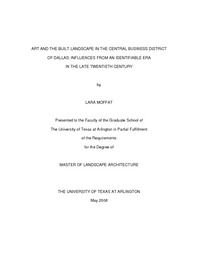
ATTENTION: The works hosted here are being migrated to a new repository that will consolidate resources, improve discoverability, and better show UTA's research impact on the global community. We will update authors as the migration progresses. Please see MavMatrix for more information.
Show simple item record
| dc.contributor.author | Moffat, Lara | en_US |
| dc.date.accessioned | 2008-08-08T02:31:10Z | |
| dc.date.available | 2008-08-08T02:31:10Z | |
| dc.date.issued | 2008-08-08T02:31:10Z | |
| dc.date.submitted | May 2008 | en_US |
| dc.identifier.other | DISS-2029 | en_US |
| dc.identifier.uri | http://hdl.handle.net/10106/942 | |
| dc.description.abstract | In the mid to late 1970s, Dallas' emergence as a center of culture and art became outwardly evident in the urban landscape. International and local designers were commissioned to make their mark on the grided environment; Dallas City Hall was the first major development during this period. Internationally acclaimed architect I.M. Pei's inverted pyramidal structure and ceremonial plaza were soon followed by Carpenter Park with its noteworthy environmental art piece 'Portal Park Slice' by Robert Irwin.
Significant human communities typically have a collection of spaces that are both private and public, mostly privately funded but publicly used. In the sites' development a group of financiers, developers, designers, artists and in some cases, city officials and individual citizens outlined the usage by defining the purpose and function of the site in order to aesthetically achieve their means. Behind this collaboration, amass a series of stories; narratives that explain the who, why and what in the development of each project. In this paper, historical backgrounds are presented making the user aware of the inner makings of these urban spaces.
This study revealed the collaborations of the individuals involved in the development of the sites and the specifics behind the projects. Publications from both the defined era and present provided vital recorded facts. Site inventories confirmed inclusion of art and offered photographic documentation. Through the use of research methodology, literature review, artists' comments and critics' response, this research details how eight selected built landscapes within the Central Business District (CBD) of Dallas that include art as a significant feature were a direct result of the construction boom in the later part of the twentieth century.
In the mid to late 1970s, Dallas’ emergence as a center of culture and
art became outwardly evident in the urban landscape. International and local
designers were commissioned to make their mark on the gridded environment;
Dallas City Hall was the first major development during this period.
Internationally acclaimed architect I.M. Pei’s inverted pyramidal structure and
ceremonial plaza were soon followed by Carpenter Park with its noteworthy
environmental art piece ‘Portal Park Slice’ by Robert Irwin.
Significant human communities typically have a collection of spaces
that are both private and public, mostly privately funded but publicly used. In the
sites’ development a group of financiers, developers, designers, artists and in some cases, city officials and individual citizens outlined the usage by defining
the purpose and function of the site in order to aesthetically achieve their
means. Behind this collaboration, amass a series of stories; narratives that
explain the who, why and what in the development of each project. In this
paper, historical backgrounds are presented making the user aware of the inner
makings of these urban spaces.
This study revealed the collaborations of the individuals involved in the
development of the sites and the specifics behind the projects. Publications
from both the defined era and present provided vital recorded facts. The written
review led to qualitative observational research, specifically the inventory and
documentation of the sites. Site inventories confirmed inclusion of art and
offered photographic documentation.
Through the use of research methods, literature review, artists’
comments and critics’ response, this research helped answer the hypothesis:
who or what created built landscapes within the Central Business District (CBD)
of Dallas in the later part of the twentieth century that included art as a
significant feature of the design?
The main influences discovered were regional growth, being oil rich
during the oil crisis of the mid 1970s and having less restrictive planning
guidelines. These factors attracted foreign developers who in turn involved
international talents such as I.M Pei and Philip Johnson; designers working in
markets where urban plazas and noteworthy art were commonplace. | en_US |
| dc.description.sponsorship | Taylor, Pat D. | en_US |
| dc.language.iso | EN | en_US |
| dc.publisher | Landscape Architecture | en_US |
| dc.title | Art And The Built Landscape In The Central Business District Of Dallas: Influences From An Identifiable Era In the Late Twentieth Century | en_US |
| dc.type | M.L.A. | en_US |
| dc.contributor.committeeChair | Taylor, Pat D. | en_US |
| dc.degree.department | Landscape Architecture | en_US |
| dc.degree.discipline | Landscape Architecture | en_US |
| dc.degree.grantor | University of Texas at Arlington | en_US |
| dc.degree.level | masters | en_US |
| dc.degree.name | M.L.A. | en_US |
| dc.identifier.externalLink | https://www.uta.edu/ra/real/editprofile.php?onlyview=1&pid=1152 | |
| dc.identifier.externalLinkDescription | Link to Research Profiles | |
Files in this item
- Name:
- umi-uta-2029.pdf
- Size:
- 3.840Mb
- Format:
- PDF
This item appears in the following Collection(s)
Show simple item record


